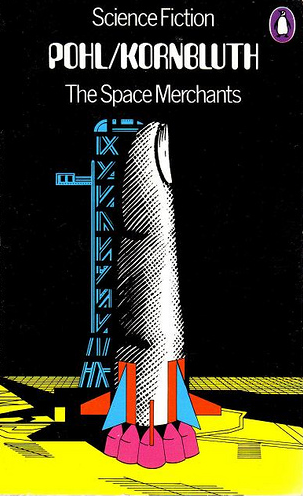SpaceX launched 60 small orbiting spacecraft for its global internet 'space race'.
(The Space Merchants is a 1952 science fiction novel by American writers Frederik Pohl and Cyril M. Kornbluth. Above cover 1974 David Pelham)
As SpaceX and its CEO verbal waffle, despite the hype of his Mars bound space carriers, it is an attempt at cornering the Space Freight and satellite market. Which has been of late scrutinised by the American government as SpaceX rushes projects in its ad hoc fervour, cries foul when the billion dollar company loses government contacts (due to its sloppy proposals) to other Space Freight competitors, as the controversy over falsified checks by an employee at one of SpaceX suppliers who built components for their rockets. Thus effecting SpaceX's safety standards as it now has a growing track record of blowing up rockets in the last few years - including its contracted payloads. Which is indicative of SpaceX's desperation in maintaining a cartel at all costs, whilst delivering so called affordable Internet to the world. The concern is, if left unchecked, this new Space race, not just SpaceX but also their competitors, will only assit in sending more junk into the lower and upper atmospheres of the Earth's orbit. As a telecommunication digital 'bubble' to spread thousands of small satellites that will float in short or in most cases long term prograde orbits, that, by the grace of gravity hopefully will not end up being missiles for the International Space Station or in a worst case scenario setting off a chain reaction junk fest of satellite debris. Despite the hype and catch-cries from the billionaire mentioned and his hyped concepts, the internet that will now ascend into the heavens to deliver faster social media feeds - holds very little appeal. As the night sky will be polluted by bits of orbiting rubbish.
From Scientific American
"Today Earth orbit is a busy place. Almost 2,000 active satellites whiz around our planet, along with nearly 3,000 dead satellites and 34,000 pieces of “space junk” larger than 10 centimeters in size. Whenever debris or a defunct spacecraft gets too close for comfort to an active satellite—typically when a collision risk rises to one part in several thousand—the satellite’s operator must perform a collision-avoidance maneuver. The International Space Station, for example, is moved when the chance of a collision is greater than one in 10,000.
These close encounters already occur thousands of times each year, but the sheer vastness of mega constellations such as Starlink will change the game, resulting in an estimated 67,000 annual collision-avoidance maneuvers if all of them are launched. As Earth orbit becomes jam-packed with satellites, the risk increases. A worst-case scenario would be the Kessler syndrome, a positive feedback loop in which debris-generating collisions create more and more collisions, which in turn create more and more debris, rendering parts of Earth orbit essentially unusable..."



Comments
Post a Comment